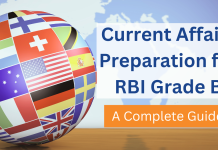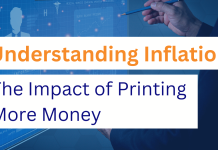Inflation refers to a sustained increase in the general price level of goods and services in an economy over a period of time. It erodes the purchasing power of individuals and can have serious consequences for the overall economic stability and growth of a nation. As such, controlling inflation is a key responsibility of central banks, with the Reserve Bank of India (RBI) playing a crucial role in managing inflation in India. This blog will delve into the various measures taken by the RBI to control inflation and their effectiveness.
What Is Inflation?
Inflation refers to the general increase in prices of goods and services over a period of time, resulting in a decrease in the purchasing power of money. It is typically measured by the Consumer Price Index (CPI) and expresses the percentage change in the average price level. Inflation can have various causes, such as an increase in the costs of production, higher demand for goods and services, or changes in government policies and regulations.
While moderate inflation is generally considered healthy for an economy as it indicates economic growth and stability, high inflation can lead to several adverse effects, including a decrease in real income, reduced savings value, and the erosion of people’s purchasing power. Central banks often aim to maintain a target inflation rate to strike a balance between economic growth and price stability.
Causes of Inflation
Inflation is a term used to describe the persistent increase in the general price level of goods and services in an economy over a period of time. It is measured by the Consumer Price Index (CPI) and is influenced by various factors. Lets discuss the main causes of inflation.
1. Demand-Pull Inflation:
Demand-pull inflation occurs when the aggregate demand for goods and services exceeds the economy’s capacity to supply them. This can happen due to several reasons, such as increased consumer spending, government expenditure, or lax monetary policies. As demand rises, businesses may respond by increasing prices, leading to inflation.
2. Cost-Push Inflation:
Cost-push inflation is caused by an increase in the cost of production for businesses. This can occur due to various factors, including rising wages, higher raw material costs, or increased taxes and regulations. When businesses face higher costs, they often pass on these expenses to consumers in the form of higher prices, leading to inflation.
3. Monetary Inflation:
Monetary inflation occurs when there is an increase in the money supply in the economy. This can happen when central banks engage in expansionary monetary policies, such as lowering interest rates or engaging in quantitative easing. As the money supply increases, the purchasing power of each unit of currency decreases, leading to a rise in prices.
4. Import Inflation:
Import inflation occurs when the prices of imported goods and services increase due to currency depreciation or higher international prices. If a country heavily relies on imports, an increase in the price of these goods can lead to inflationary pressures in the domestic economy.
5. Expectation Inflation:
Expectation inflation is driven by the expectations of businesses and consumers regarding future price levels. If people anticipate that prices will rise, they may engage in hoarding or speculative activities, leading to an increase in demand and subsequent inflation.
Role of RBI in Controlling Inflation
Here we are enlisting the role of RBI in controlling inflation.
1. Monetary Policy Framework:
The RBI formulates and implements the monetary policy of India, which primarily focuses on maintaining price stability. The central bank uses various tools at its disposal to manage inflation. One such tool is the repo rate, which is the rate at which the RBI lends money to commercial banks. By hiking the repo rate, the RBI makes borrowing more expensive for banks, thereby reducing their ability to lend. This, in turn, reduces the money supply in the economy, curbing inflationary pressures.
2. Cash Reserve Ratio (CRR):
The RBI also stipulates the cash reserve ratio (CRR) for banks, which is the percentage of deposits that banks are required to keep with the central bank. By increasing the CRR, the RBI reduces the funds available for lending by banks, thereby restricting the money supply and controlling inflation.
3. Open Market Operations (OMO):
Open market operations refer to the buying and selling of government securities in the open market by the central bank. By selling government securities, the RBI absorbs excess liquidity from the market, reducing the money supply and curbing inflationary pressures. Conversely, by buying government securities, the RBI injects liquidity into the market, stimulating economic growth and countering deflationary pressures.
4. Quantitative Tools:
Apart from the above measures, the RBI also uses quantitative tools such as statutory liquidity ratio (SLR) and liquidity adjustment facility (LAF) to manage inflation. The SLR requires banks to maintain a certain percentage of their deposits in the form of government securities. By increasing the SLR, the RBI restricts the ability of banks to lend, thus reducing the money supply and curbing inflation. The LAF allows banks to borrow from or lend to the RBI on a short-term basis, helping to manage liquidity in the banking system and control inflation.
5. Inflation Targeting:
Since 2016, the RBI has adopted a formal inflation targeting framework, with the aim of maintaining a specified target level of inflation. The target is set by the government in consultation with the RBI, and the central bank adjusts its policies to achieve this target. This approach provides clarity and transparency to stakeholders and helps anchor inflation expectations, which is crucial in controlling inflation.
6. Supervision and Regulation:
The RBI plays a vital role in supervising and regulating the banking sector in India. It monitors the operations of banks to ensure that they adhere to prudent lending practices and maintain adequate capital and liquidity buffers. By doing so, the RBI aims to prevent excessive credit growth and speculative activities that could lead to inflationary pressures.
7. Exchange Rate Policy:
The RBI manages the exchange rate of the Indian rupee against other currencies. A depreciating rupee can lead to imported inflation, as the cost of imported goods and commodities increases. The RBI intervenes in the foreign exchange market to stabilize the rupee and prevent excessive inflation caused by external factors.
8. Communication and Guidance:
The RBI emphasizes effective communication and guidance to the public and market participants regarding its policy stance on inflation. By providing clear communication about its inflation goals and policy measures, the central bank helps in shaping market expectations, which can influence inflationary pressures and behavior.
Effectiveness of RBI’s Measures:
The effectiveness of the RBI’s efforts to control inflation can be seen in the recent years’ inflation data. Inflation in India has largely remained within the target range set by the RBI. The inflation targeting framework, coupled with the use of various monetary tools, has helped in anchoring inflation expectations and maintaining price stability.
However, it is important to note that controlling inflation is a complex task and influenced by various factors such as global commodity prices, supply-side constraints, and fiscal policy. The RBI’s measures can only act as a catalyst, and coordinated efforts from various stakeholders are necessary to achieve long-term inflation control and economic stability.
Conclusion
The RBI plays a critical role in controlling inflation in India. Through its monetary policy framework, quantitative tools, supervision, and regulation of banks, exchange rate policy, and effective communication, the central bank aims to maintain price stability and promote sustainable economic growth. While the success of these measures depends on various external factors, the RBI’s efforts have been instrumental in keeping inflation under control and ensuring a stable economic environment for the country.
Get Free Online Test Series, GK updates in form of Beepedia, BeeBooster, as well as latest updates for Bank PO, Bank Clerk, SSC, RBI, NABARD and Other Government Jobs.















